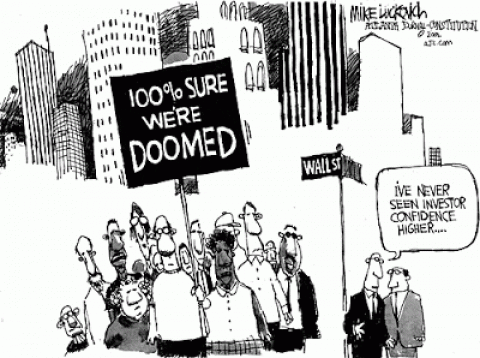Not Just the Long-Term Unemployed: Those Unemployed Zero Weeks Are Struggling to Find Jobs
Leave aside for a moment the difficulty that the long-term unemployed, those who were unlucky and have been looking for a job for more than 52 weeks, have in finding a job. Even those who have been unemployed zero weeks are having trouble finding jobs in this economy. And this is important evidence against the idea that the labor market is doing better than people realize if you just ignore the long-term unemployed.
Here’s a data point that I’m particularly interested in: how often are employed people going straight to another job, rather than leaving their job and enduring a period of unemployment before finding new work?
Though most people think of the employed spending some time in unemployment before starting a new job (an idea that was central to the recent theory that quit rates predicted a healthy job market), a substantial number of people move directly from one job to another without ever counting as unemployed. Since our statistics (and most of the economic models) are set up to observe people who are looking for work but are unable or unwilling to accept a job, these steadily employed workers can go missing in the discussion. That’s a shame, because historically they comprise almost half of all those who accept a new job.
The Rortybomb blog has long been a fan of the job flows data, or the statistics that show who is moving between employment and unemployment and in and out of the labor force. However, the easiest way to access this data didn’t distinguish between those who stayed employed with a single employer and those who stayed employed but moved between different employers.
Luckily, someone pointed me in the direction of the Employer-to-Employer Flows in the U.S. Labor Market [1], compiled by the Federal Reserve, which breaks out those who move from one employer to another without being unemployed (described as “EE transitions” for the rest of this post). This data is current through the end of 2013.
If the economy is heating up significantly and the long-term unemployed aren’t capable of taking jobs, then the EE transition rate should be increasing. So how is it doing?

This is the percentage of the employed who are in EE transition (the results are the same for EE transition as a percentage of the labor force). As we can see, it declined during the crisis and hasn’t recovered even as of 2013.
Let’s also look at this from a different point of view: what percentage of those taking jobs are currently employed? If the economy was heating up and the unemployed or those out of the labor force couldn't take jobs, we would expect this to increase. Taking EE transitions as a percentage of all those who are transitioning into new jobs, we see the following:

New hires are increasingly coming from the ranks of the unemployed and those not in the labor force rather than the currently employed. Where the employed were 40 percent in the 1990s, and 35 percent in the pre-crisis 2000s, it's down to 30 percent now.
Why does this matter? First off, these quits also create a new job opening, which the unemployed can take. There’s a significant labor economics literature that argues that job-to-job transitions are a major driver of wage growth for workers (starting here and continuing to this day, h/t Arin Dube). If the number of people moving directly from one job to another is in decline, that’s a bad sign for wage growth, as well as inflation and monetary policy. This appears to be undertheorized and not discussed enough in academic or policy discussions.
But why is this happening? The American Time Use Survey hasn’t been able to tell me whether the employed are spending more or less time searching for other jobs since the recession started; the sample size is too small to make conclusive predictions about changes. If potential wage gains are a primary motivation of job-to-job transitions, then lack of wage growth or even inflation could be contributing to less churn in the economy.
When it comes down to it, the problems of those who aren’t working and want a job are similar to the problems of those who are working but want a new job. As Alan Krueger found in this chart in his recent paper (also see Ben Casselman's chart here), the rate of successful job searches is down not just for the long-term unemployed, but also for the short-term unemployed, when compared to 2007. It appears the same holds true for those with an unemployment duration of zero.
[1] The page indicates that it was last updated in 2004, or perhaps 2011. But the excel document has data through the end of 2013. Sneaky.


Spread the word